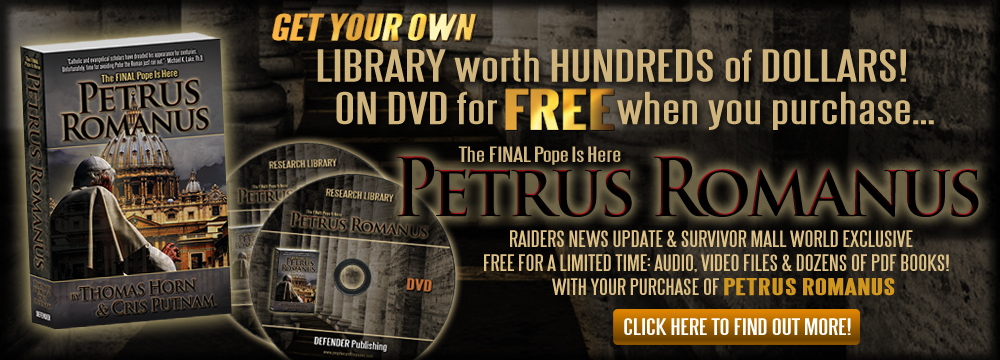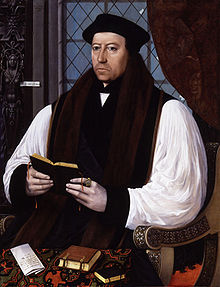 I recently traveled to Oklahoma City to film a couple episodes of Prophecy in the News, I really enjoyed meeting Gary Stearman and Bob Ulrich and discussing our new book. Here is the first episode:
I recently traveled to Oklahoma City to film a couple episodes of Prophecy in the News, I really enjoyed meeting Gary Stearman and Bob Ulrich and discussing our new book. Here is the first episode:
Prophecy in the News Discusses Petrus Romanus
Temple Mount Faithful Call Everyone in the World to Send a Letter to the Pope
 In light of what we have written in Petrus Romanus the timing of this campaign is especially poignant:
In light of what we have written in Petrus Romanus the timing of this campaign is especially poignant:
The Temple Mount and Land of Israel Faithful Movement sent a letter to Pope Benedict XVI in Rome requesting him to return to Israel — without delay — the Holy Temple Menorah, the vessels, and the treasures that were stolen by the Romans and taken to Rome when they destroyed the Holy Second Temple in Jerusalem in the year 70 ce. These Temple vessels will be used by the priests of Israel in the Holy Third Temple.
We are working intensively so that the Holy Third Temple will soon be built in the lifetime of our generation. By this act we are answering the prophetic call of the G‑d of Israel to His People to rebuild His Holy House on the Holy Temple Mount in Jerusalem now, as Israel is experiencing the climax of the time of redemption in the Holy Land of Israel.
Read More: http://www.templemountfaithful.org/Articles/letter-to-the-pope.htm
The Papacy as Antichrist into the 20th century with Charles Hodge
By Cris D. Putnam
 The view of an antichrist pope dominated the late nineteenth and early twentieth century. Even Catholics came to similar conclusions. George Tyrrell, a Jesuit priest and controversial modernist theologian, was excommunicated in 1908 after he also came to the conclusion that papacy was antichrist. He stated,
The view of an antichrist pope dominated the late nineteenth and early twentieth century. Even Catholics came to similar conclusions. George Tyrrell, a Jesuit priest and controversial modernist theologian, was excommunicated in 1908 after he also came to the conclusion that papacy was antichrist. He stated,
“I believe in the Roman Church so far as it is Christian and Catholic; I disbelieve in it so far as it is papal. I see two spirits in it, as in myself, struggling for supremacy—Light and Darkness, Christ and Anti-Christ; God and the Devil.”[1]
Another figure in turn of the century theology, Charles Hodge, who served at Princeton theological seminary from 1872 to 1929, also argues convincingly that the papacy is antichrist. His treatment of the antichrist in his Systematic Theologyis so influential that it will also be examined more thoroughly.

Charles Hodge: "But to be the Vicar of Christ, to claim to exercise his prerogatives on earth, does involve a claim to his attributes, and therefore our opposition to Popery is opposition to a man claiming to be God."
One can readily see why Turretin’s theology text’s remarkable shelf life at Princeton was ended by Hodge. It is a pleasure to read and study Hodge’s work as he has a more winsome style and is more exegetically coherent. If the reader has any lingering doubt about the notion that the papacy is a manifestation of antichrist, studying Hodge will likely persuade. Hodge makes most of the same points as Turretin and the other reformers but he allows more flexibility. That tractability and his rigorous intellectual honesty are his strong points. Keeping in mind this work was published at the dawn of the twentieth century, Hodge addresses the “temple of God” reference in 2 Thessalonians: “Some, however, suppose that the reference is to the literal temple in Jerusalem; but this supposes, (a.) That the Jews are to be restored to their own land. (b.) That they are to be restored as Jews, or unconverted, and that the temple is to be there rebuilt.”[2]
While Hodge was incredulous it would ever occur, it is more than a little exciting that since this writing the Jews have been restored to their land and that they are planning to rebuild the temple, already having placed a cornerstone, and still in an unconverted state.[3] As discussed elsewhere, even more persuasive is the possibility that Rome is driving the process. Hodge clearly believed the papacy was antichrist. He demolishes Anglican turncoat John Henry Newman’s argument that this line of reasoning necessarily condemns all Catholic believers. He argues it is a non-sequitur because the Church of Rome can be understood in different aspects, the arrogant hierarchy of the papacy and the body of professing believers. He breaks new ground in reformed polemics by generously offering, “That many Roman Catholics, past and present, are true Christians, is a palpable fact.”[4] This is refreshing because it does not necessarily follow that the papacy being part of the antichrist system damns all Catholics.
Additionally, he does not rigidly rule out other manifestations like Turretin. He states, “Admitting that the Apostle’s predictions refer to the Roman pontiffs, it does not follow that the papacy is the only antichrist.”[5] This accounts for John’s teaching that the Antichrist (singular) is coming as many antichrists had come (1 Jn 2:18). Hodge carries this line of thinking further offering, “the same power, retaining all its essential characteristics, may change its form.”[6] His intellectual honesty in accounting for more than one potential manifestation is inspirational. As noted above, Wesley and Spurgeon were also sympathetic to the possibility of an ultimate future Antichrist just prior to Jesus’ return. Is it possible that papacy still might fulfill this ultimate sense as well? Could there be a satanic presence in the Vatican which is leading toward that final confrontation? There is fascinating evidence presented in Petrus Romanus: the Final Pope is Here which suggests it.
[1] David F. Wells, “The Pope as Antichrist: The Substance of George Tyrrell’s Polemic” (Harvard Theological Review 65, 2 April 1972) 271–283.
[2] Charles Hodge, Systematic Theology, 3:815.
[3] “The Temple Mount Faithful Movement Held On ‘Jerusalem Day” the Most Exciting Event in Israel Since the Destruction of the Holy Temple in 70 CE,” TempleMountFaithful.org, last accessed October, 11, 2011, http://www.templemountfaithful.org/Events/jerusalemDay2009-2.htm.
[4] Charles Hodge, Systematic Theology, 3:822.
[5] Ibid.
[6] Ibid., 3:825.
Prophecy in the News: Petrus Romanus
I was honored to appear on Prophecy in the News today with my co-author Tom Horn and our generous host Gary Stearman. Also a big thanks to Bob Ulrich for all of his work.
The Papacy as Antichrist: Cramner, Knox, Wesley & Spurgeon
By Cris D. Putnam
It is a demonstrable historical fact that every notable protestant theologian of the 16-19th century, regardless of denomination, believed and taught that the papacy was antichrist. In the British Isles, Thomas Cranmer was the Archbishop of Canterbury during the reigns of Henry VIII, Edward VI, and for a very short time for Mary I. He was successful under the former two, famously composing the Book of Common Prayer which is still in use today. Of course, his Protestant stance was what led the staunchly Catholic Queen, “bloody Mary,” to execute him. However, he was first tortured by watching his close friends being brutally executed. Under such duress, he signed a statement denying Protestantism and was scheduled to make a public profession just prior to his own execution. Instead, he recanted the coerced statement saying, “As for the Pope, I refuse him as Christ’s enemy and Antichrist, with all his false doctrines” and thus he died honorably as a reformation martyr.[1]
The Scottish reformer, John Knox, held similar views to Calvin and other reformers. He had been captured from his native land by the French and forced into slave labor until he was released to England where he served the Anglican King Edward VI. When bloody Mary ascended to the throne, he moved to Geneva where he met Calvin. Accordingly, he learned reformed theology and on his subsequent return home led the Protestant Reformation in Scotland. His writings on the papacy as antichrist are extensive. A word search of The Works of John Knox using the search terms “antichrist” and “Roman” returns an astonishing 102 occurrences in thirty-six articles. He stated, “Yea, we doubt not to prove the kingdome of the Pope to be the kingdome and power of Antichrist.”[2]Indeed, the reformers had little doubt. But is this just a Lutheran and Calvinist construct?
Lest one begin to think that this belief was particular to Calvinism, it is essential to examine the opinions of John Wesley. Of course, Wesley was Arminian in his theology and the founder of Methodism. He wrote a book entitled, Antichrist and His Ten Kingdoms, where he said of the pope, “He is in an emphatical sense, the Man of Sin…”[3] In his commentary on Revelation, he wrote, “The beast with seven heads is the Papacy of many ages: the seventh head is the man of sin, antichrist. He is a body of men from Re 13:1–17:7; he is a body of men and an individual, Re 17:8–17:11; he is an individual, Re 17:12–19:20.”[4] Wesley makes an apt observation that the biblical material points to an institution and an individual. This infers the historic/futurist hybrid interpretation mentioned earlier. It is also seen in the writings of Charles Spurgeon.
Spurgeon, the prince of preachers, wrote eloquently about the apostasy of the Church into the system of Antichrist. He also had little doubt and argued the point forcefully. For instance, in one sermon, he expounds on the clever strategy of Satan’s evil world system:
Then the world changed its tactics; it became nominally Christian, and Antichrist came forth in all its blasphemous glory. The Pope of Rome put on the triple crown, and called himself the Vicar of Christ; then came in the abomination of the worship of saints, angels, images, and pictures; then came the mass, and I know not what, of detestable error.[5]
Far from a fanciful eschatological theory relegated to the hinterland of his thought, it was demonstrably a cornerstone in his theological discourse. He was fond of elaborating on the metanarrative of salvation history as it progressed from the apostolic era. In a later sermon, he offered concerning the digression of Roman Catholic Church, “She became like the heathen around her, and began to set up the images of her saints and martyrs, till at last, after years of gradual declension, the Church of Rome ceased to be the church of Christ, and that which was once nominally the church of Christ actually became the Antichrist.”[6] Yet, it is important to note that Spurgeon also saw a future time when the Jews would return to their own land and then, “that the power of antichrist shall be utterly and eternally destroyed, and that Babylon, that is to say, the Papal system, with all its abominations, shall be cast like a millstone into the flood, to rise no more forever.”[7]
Next the views of Charles Hodge bring us into the 20th century.
[1] Christian History: Thomas Cranmer and the English Reformation., electronic ed. (Carol Stream IL: Christianity Today, 1995; Published in electronic form by Logos Research Systems, 1996).
[2] John Knox, The Works of John Knox, Serial. (Bellingham, WA: Logos Research Systems, Inc., 2003), 4:470.
[3] John Wesley, Antichrist and His Ten Kingdoms (Public Domain), 110. (See: http://www.whitehorsemedia.com/articles/?d=44.)
[4] John Wesley, Wesley’s Notes: Revelation, electronic ed. Wesley’s Notes (Albany, OR: Ages Software, 1999), Re 13:1.
[5] Charles H. Spurgeon, Spurgeon’s Sermons: Volume 10, electronic ed; Spurgeon’s Sermons (Albany, OR: Ages Software, 1998).
[6] Charles H. Spurgeon, Sermons: Volume 12.
[7] Charles H. Spurgeon, Sermons: Volume 50.







